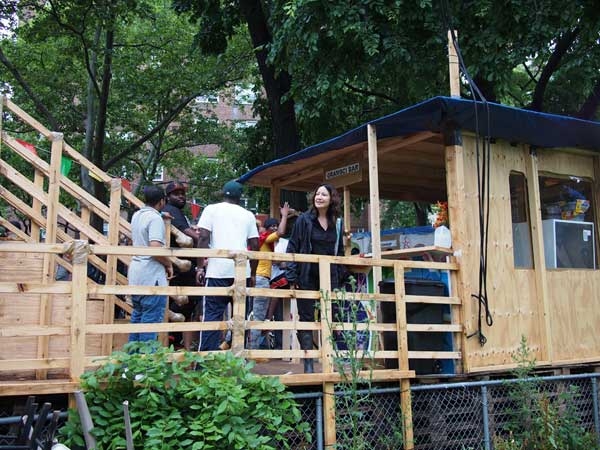It’s the dog days, and wouldn’t you know it; politics is in the air in New York. In the comic mode, former US Representative Anthony Weiner (former for having sexted pictures of his namesake to numbers other than his wife’s) has been gaining support in the city’s mayoral race; and former New York Governor Eliot Spitzer (former because of the fallout from paid time spent with a companion other than his wife) has been leading in the Democratic race for New York City comptroller. Sex sells in the Big Apple, and apparently it wins votes too.
Gramsci Monument follows Hirschhorn’s guidelines for ‘Presence and Production’ in a work in a public space
In the tragic mode, people have been taking to the streets to protest the acquittal of George Zimmerman, the Neighbourhood Watch coordinator who shot and killed seventeen-year-old Trayvon Martin in Sanford, Florida. There was a scuffle. There was a shot. Martin was dead and Zimmerman claimed it was self-defence. Whether race was a motivating factor (Martin was black, Zimmerman is not) is an open question, as is why it should be legal for anyone not in actual law enforcement to carry a gun. One excellent place to pose these questions is Thomas Hirschhorn’s temporary ‘monument’ to Italian political theorist and Marxist Antonio Gramsci (1891–1937), presented by Dia Art Foundation, which is running throughout the summer in the central court of the Forest Houses housing project in the Bronx.
Constructed in the form of an outdoor pavilion, with elements including an exhibition space, library, theatre and bar, all built and run by the residents of Forest Houses, Gramsci Monument follows Hirschhorn’s guidelines for ‘Presence and Production’ in a work in a public space, meaning that the artist will be based in the South Bronx and onsite, making work, for the duration of the project. The monument also keeps to Hirschhorn’s commitment to materials that ‘do not intimidate’. The two ‘wings’ of the construction, one housing the bar, workshop, classroom and theatre, the other a museum, library, newspaper, computer room and radio station – all fundamentals of civil culture – are constructed from low-grade two-by-fours, plywood, packing tape, and tarpaulins. There are philosophy lectures and kids workshops, weekly theatrical performances, open mic sessions, field trips (led by monument ‘ambassador’ and Dia Art Foundation curator Yasmil Raymond) and art classes (led by Hirschhorn himself). Everything is open every day from 10am to 7pm and documented in running fashion online.
Gramsci Monument is the fourth and final work in Hirschhorn’s Monuments series: works in public space focused around the ideas of figures whom Gilles Deleuze (who himself got a Hirschhorn monument, in Avignon in 2000) would have called ‘dissident philosophers’. Monuments to Spinoza (in Amsterdam in 1999) and Bataille (for Documenta XI in Kassel in 2002) being the other two.
Take that early apprehension with you, It’s the physiological embodiment of your decision to come, to see and to take part.
ArtReview found its way to Gramsci Monument before the Zimmerman acquittal, on a day when it threatened rain but never made good on it. The closest subway stop is Prospect Avenue, an above-ground platform, which does nothing for one’s sense of direction when hitting the street. There are few feelings that match the subtle dread that can set in when emerging from public transit into an alien neighbourhood that doesn’t appear to cater to tourists. Your dress, your face, your skin – everything about you can feel ‘other’. And you feel that everyone who looks at you knows it.
But here’s the thing: most won’t care, and those that do only want to make sure you get to where you’re going. Nevertheless, when you go, take that early apprehension with you as you walk to the Forest Houses, because it’s part of Hirschhorn’s project. It’s the physiological embodiment of your decision to come, to see and to take part. Every decision is a commitment, one that belongs to you, one that has effects, has consequences – or rather is consequent – and this, in large part, is what Hirschhorn’s work is about.
As the artist states over and over again, his work is for ‘energy’ and against ‘quality’. Energy is what we invest in things and people, such as radio shows, newspaper columns, classroom lessons and conversations over coffee while perched on rudimentary bar stools. It’s present in decisions that take us out of our way and out of our depths. It’s present in a work of art – and this is a paraphrase of Hirschhorn’s lesson from the Monument’s Friday art class – when that work of art offers evidence of the energy, decision and consequent thought that went into making it.
When Gramsci stated that ‘every human being is an intellectual,’ his point was not that we are all equally gifted with intelligence, but that everyone has the capacity to harness the power of ideas. Such capacity requires effort. It requires making a decision, such as taking a train to the Bronx and walking to the Forest Houses, and having a conversation, perhaps about Weiner or Spitzer, but more likely about Gramsci, or about race, or guns, or art.
Thomas Hirschhorn: Gramsci Monument, to 15 September 2013, Forest Houses, Bronx, New York. Dia Art Foundation
23 July 2013
